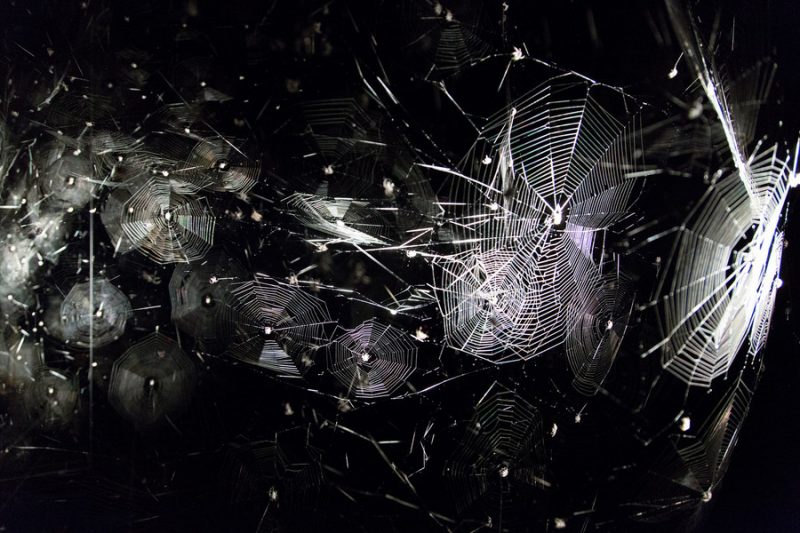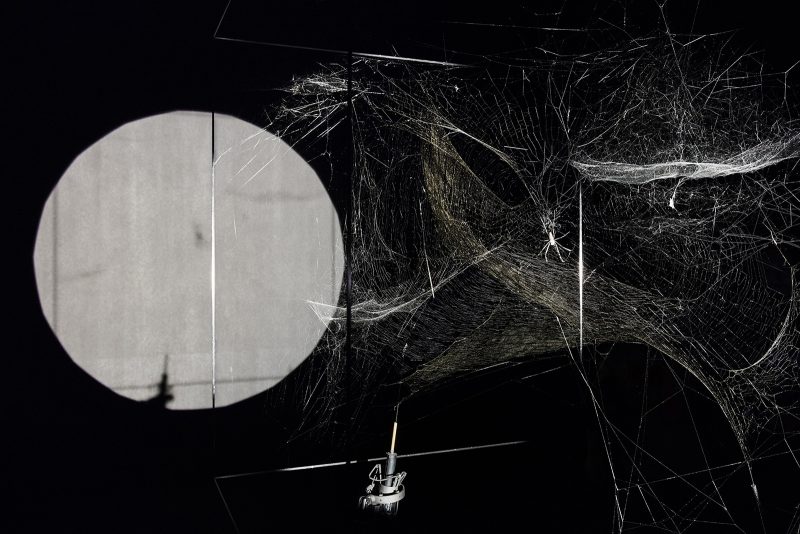In two dark, cavernous galleries of the Museo de Arte Moderno (MAMBA) in Buenos Aires, an unusual show designed by internationally acclaimed, Argentinian-born, artist Tomás Saraceno boasts the craftsmanship of a few thousand spiders. The prolific artist is trained in architecture and has an incredible array of interdisciplinary accomplishments under his belt; he has completed NASA’s International Space Studies Program, exhibited in the 2009 Venice Biennale, was the first artist to hold a residency at MIT, has been the recipient of a slew of awards, and much more. In his first solo show at a major institution in his home country, Saraceno devises two fascinatingly complex spaces filled solely with the webs of 7,000 Parawixia bistriata spiders built up over the course of six months. The exhibition, Cómo atrapar el universo en una telaraña (How to entangle the universe in a spider web), is a research based, conceptual culmination of Saraceno’s interest in philosophy, astrophysics, arachnology, and the arts based on over a decade of research.
First, a word about the spiders: The species of spider, Parawixia bistriata, native to northern Argentina, was chosen because of its unique (in the world of spiders) ability to live socially before reaching maturity. From birth until about six months of age, Parawixia bistriata spiders live communally before branching off and isolating themselves like most other spiders. In that sense, the webs are representative of gigantic spider cities. Though the spiders were long gone (returned to the wild) by the time I arrived at the gallery, their webs remained, reminders of the arachnids’ former movements and former homes.
Walking into the black box galleries, the viewer is faced with massive clusters of webs that seem to glow in the dim lighting. With nothing but a minimal rope framework and their near alchemical ability to create silken webs, the spiders turned an essentially empty room into what the artist called a simultaneous macro- and microcosmic representation of the connections in the universe. As Saraceno wrote in his press release, “We all began to work together, to take our place in the universe; each of us was just another piece in the cosmic framework to which we all belong like a web in which the different elements transform one another. A spider weaving its threads, a particle of cosmic dust floating in space, a human being breathing it in, a galaxy to contain it all”.

In the installation “Quasi-Social Musical Instrument IC 342”, the structures resemble an extremely scaled down model of the cosmos, clusters of universes and connections hinting at String Theory lighting up the otherwise barren and dark space. Saraceno has a self professed fascination with cosmic dust (also known as stardust), and the webs are on some level an attempt to capture the elusive substance. This is of course easier said than done, and so the artist settled for catching the much more abundant terrestrial equivalent, regular earthly dust. It is rather poetic; after six months of construction, the spiders’ architectural structures have become veritable dust magnets. Floating dust that surrounds us at all times has built up on the webs over the four months they’ve spent untouched in the gallery, leaving the structures fuzzy and constantly vibrating with the airflow of the room.
In the installation “The Cosmic Dust Spider Web Orchestra”, visitors enter a second dark room to become witness to a live audio performance. Magnified for the human ear to hear, ominous sounds continuously play in the background. A bright spotlight in the dark brings into focus the plethora of dust constantly surrounding us. Through the technology of a three-dimensional camera, the relative speed and velocity of the abundant dust particles are converted into sound that is played back in the gallery in real time. Though it is comprised entirely of terrestrial components, this was truly a trippy, otherworldly experience.

Saraceno’s webs are extremely site specific, to the point that I doubt they can be moved from the gallery without damage. This surreal space has a limited lifespan, one of the more fascinating aspects of this show. There is beauty in the transience of this work, it — like us- occupying a specific niche in the cosmic framework Saraceno theorizes. The artist left the actual task of creation to nature, refreshing in a world of toxic and artificial art media.
Cómo atrapar el universo en una telaraña ended at the Museo de Arte Moderno, Av. San Juan 350 San Telmo, Buenos Aires, Argentina, closed on September 28th.
For those on the U.S. East coast, Saraceno currently has a solo show that includes a spider piece — and a new commissioned work — at the Baltimore Museum of Art, 10 Art Museum Drive, Baltimore, MD 21218, entitled Entangled Orbits, up now through June 10, 2018.






